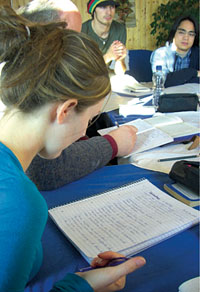Competences through learning
Learning is understood as follows:
- Learning is based on activity. It is fundamental to the human condition.
- Learning is a continuous process of comparing what is intended with what is achieved.
- Learning inherently includes fault and failure, error and misunderstanding. These are vital elements of learning. Learning shows the desire to improve one’s actions so as to reach a higher degree of achievement.
- A teacher’s aspiration to expel all fault and failure from his classroom by penalising errors and mistakes actually prohibits learning.
- Reflection is an essential element of comparison. There is no learning without reflection.
- Depending on age, maturity and circumstance, reflection ranges from a relatively unconscious process of imitation (a kind of mirroring) through a half-conscious process of pondering, daydreaming or musing to fully awake reflection, which generally comprises
- reviewing the goal and asking what was achieved,
- reflecting the circumstances and the context in which the activity took place and
- evaluating the process and the degree of achievement.
- The first step in learning to learn [6] is to become aware of the process of learning through reflection. Portfolio is designed to help a student learn how to learn (and the teacher how to advise and coach the student to do so).
- Learning is an individual process; it cannot be standardised or normalised. ‘Equal opportunity’ cannot mean that all stu- dents must learn the same thing at the same time and at the same pace for the same reason. It means giving the student the opportunity to devise his or her own learning strategy. This is also an element of working with portfolio.
|


“The portfolio-jungle is an exciting place for learner and teacher survival training – and a perfect place to play hide and seek as well.”
(T. Koch)
|

